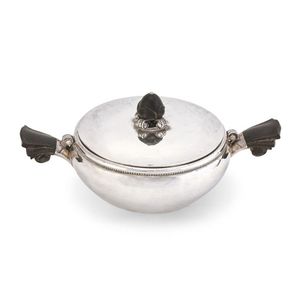Art Deco Silver Ecuelle with Ebony Handles and Finial
You must be a subscriber, and be logged in to view price and dealer details.
Subscribe Now to view actual auction price for this item
When you subscribe, you have the option of setting the currency in which to display prices to $Au, $US, $NZ or Stg.
- Ecuelle - An ecuelle is the French term for a shallow, bowl-shaped dish used for serving soup or stew. The term is also sometimes used more broadly to refer to any small, round dish used for serving food. In the Middle Ages, ecuelles were often made of pewter or other metal and were an essential part of tableware. They were used to serve a variety of dishes, including soups, stews, sauces, and porridge, and could also be used as drinking vessels. Today, ecuelles are still used in traditional French cooking and are often made of porcelain or silver.
- Finial - An architectural decoration, found on the upper parts of of an object. On furniture they are usually found on pediments, canopies and shelf supports. On smaller ceramic or silver items, such as spoons, they may decorate the top of the item itself, or the lid or cover where they provide a useful handle for removal.
Finials have a variety of shapes and forms. They may be urn-shaped, baluster shaped round or spiral, but usually taper into an upper point. Many real life shapes may also be used as finials, such as pineapples, berries, pinecones, buds, lotus and acorns. Sometimes animals such as a lion are depicted, or fish and dolphins. - Ebony - Ebony is a close grained timber, black in colour. It has a fine texture which can be polished to a high gloss, making it suitable for venereering, inlay and stringing and its use as solid timber is resticted to small decorative items and ornamental decoration, such as chess pieces and musical instrument parts. The term "ebonised" means "faux ebony", timber that has been darkened during the polishing process to resemble ebony.
- Art Deco Period - The Art Deco period was a cultural movement that emerged in the 1920s and 1930s, and was characterized by its emphasis on modernism, luxury, and elegance. The name "Art Deco" comes from the Exposition Internationale des Arts Décoratifs et Industriels Modernes, a large exhibition held in Paris in 1925 that showcased the latest trends in decorative arts.
Art Deco was a reaction against the ornate and elaborate styles of the previous era, and reflected a new modern sensibility. It was characterized by streamlined, geometric shapes, bright colours, and the use of new materials such as chrome, glass, and Bakelite. Art Deco designers sought to create a sense of luxury and sophistication, often incorporating expensive materials such as ivory, marble, and rare woods.
Art Deco had a significant impact on a wide range of artistic fields, including architecture, fashion, graphic design, and interior design. Some of the most iconic examples of Art Deco architecture include the Empire State Building in New York City, the Hoover Building in London, and the Palais de Chaillot in Paris.
The Art Deco period came to an end in the 1940s, as World War II and changing cultural trends led to a shift in artistic styles. However, Art Deco remains an important influence on design and art, and continues to be celebrated for its modernist sensibility and glamorous aesthetic.
This item has been included into following indexes:
Visually similar items

A small Georgian sterling silver tea pot, Edward, Edward Jun, John and William Barnard, London, circa 1836/1837 round and tapering with rubbed engraved decoration, some damage to handle, total weight of silver 426grs, 11 cm high

Three Wedgwood black basalt wares: a teapot, cup and saucer. The teapot of compressed form with an Egyptian handle and glazed to the interior, marked Wedgwood 24 3A 62 to the foot rim; the cup with a glazed interior and saucer, both of unadorned form, mark

English hallmarked sterling silver teapot with an enbonised handle and finial. Sheffield, 1924, maker Mappin and Webb weight including handle and finial 660g

An Atomic cappuccino maker. 1960's
